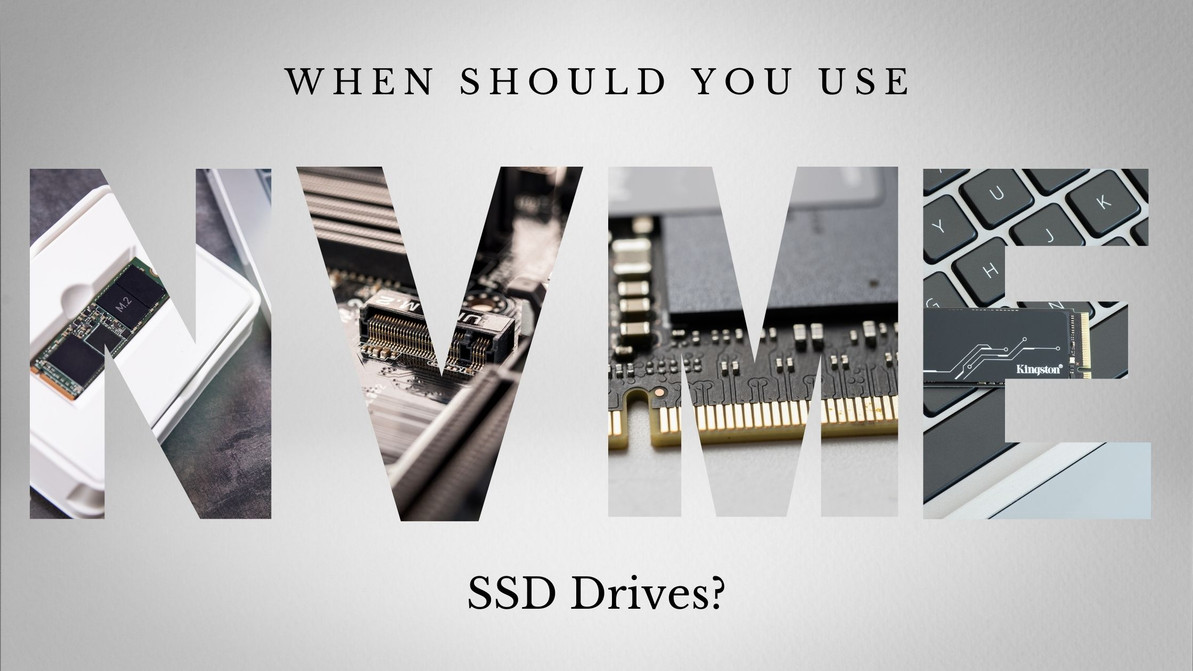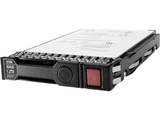When to Level Up to NVMe SSDs: Insights for IT Professionals
In the constantly evolving landscape of technology, keeping abreast with the latest advancements can significantly enhance your IT infrastructure's efficiency and performance. Among these breakthroughs, NVMe (Non-Volatile Memory Express) SSDs stand out as a pivotal leap forward, especially when compared to their SATA counterparts. But the question arises, when should you leverage the power of NVMe SSDs for your projects or organization? This guide meticulously dissects the benefits, practical applications, and considerations associated with NVMe SSD technology, poised to inform and steer your decision-making process.
Introduction to NVMe SSDs
Understanding NVMe Technology: A Leap in SSD Performance
NVMe technology emerges as the linchpin in SSD innovation, designed from the ground up to exploit the full breadth of high-speed PCIe (Peripheral Component Interconnect Express) interfaces. This contrasts sharply with the older SATA SSDs, which were confined by legacy storage paradigms and interfaces. The introduction of NVMe SSDs brings not just improvements but transformational change to data transfer speeds and access latency, heralding a new dawn in storage solution efficiency.
The Basic Differences: NVMe SSDs vs. SATA SSDs
Succinctly put, NVMe SSDs transcend SATA SSDs in terms of performance. This divergence isn't merely incremental but exponential, with NVMe drives boasting substantially higher throughput and lower latency, thereby enabling a more responsive and agile computing environment.
The distinction between NVMe and SATA SSDs becomes most apparent when considering their respective data transfer protocols and architectural efficiencies. SATA, originally designed for hard disk drives (HDDs), operates on a slower, parallel data transfer system, limiting its maximum bandwidth to 600MB/s. In stark contrast, NVMe SSDs harness the capabilities of the PCIe interface, enabling not just parallel but also serialized data transfers, which significantly elevates their throughput. Current generations of NVMe SSDs can achieve read/write speeds exceeding 3500MB/s, a stark leap from what SATA SSDs can deliver.
Furthermore, the command queue depth of these two technologies highlights another critical difference. SATA SSDs support up to 32 commands in a single queue, whereas NVMe SSDs can process a staggering 64,000 commands across 64,000 queues. This architectural advantage allows NVMe SSDs to perform an extensive array of operations concurrently, substantially reducing data access times and boosting overall system performance.
This profound discrepancy in performance metrics not only translates to faster boot times and quicker file transfers but also elevates the efficiency of data-intensive operations, such as real-time data processing and the running of complex simulations or databases. For IT professionals, the choice between NVMe and SATA SSDs is not just about raw speed but also about the scalability, reliability, and responsiveness of their computing infrastructure.
High-Performance Computing and NVMe SSDs
The high-speed data transfer and reduced latency of NVMe SSDs cast them as indispensable in high-performance computing tasks. Fields that demand rapid data access and processing such as video editing, 3D rendering, and scientific simulations find an unwavering ally in NVMe technology.
In environments where time and performance are of the essence, NVMe SSDs shine as the superior choice. The architectural advantages of NVMe SSDs allow them to deliver unparalleled speeds. For instance, in video editing, where the handling of large, uncompressed files can hamper productivity, NVMe SSDs drastically cut down file load and rendering times. Similarly, in 3D rendering, the swift reading and writing capabilities of NVMe drives can significantly reduce the time it takes to process complex models and textures, enabling artists and developers to iterate their designs more efficiently.
This speed is not just about saving time; it's about enhancing the capability to handle more projects, refine output quality, and meet tight deadlines with less stress. In the realm of scientific simulations, which often involve crunching vast datasets to model phenomena accurately, the reduced latency and high throughput of NVMe SSDs mean simulations run faster and more efficiently.
This efficiency not only accelerates the research process but also contributes to more precise and reliable outcomes. The critical takeaway for IT professionals in these fields is clear: investing in NVMe SSD technology is not merely an upgrade; it's a strategic move to unlock new levels of performance and efficiency.
The Gaming Advantage with NVMe SSDs
For gaming enthusiasts and professionals alike, NVMe SSDs promise an unprecedently immersive experience. By significantly curtailing load times and fostering smoother gameplay, these drives transform gaming sessions into seamless adventures devoid of frustrating interruptions. Additionally, larger game libraries and advanced graphics settings are now well within reach.
The profound impact of NVMe SSDs on gaming transcends mere technical enhancements; it revolutionizes how games are played and experienced. With the advent of NVMe SSDs, gamers can expect not just shorter load times, but also a significant reduction in in-game stuttering, particularly in open-world titles where game environments are vast and densely populated with intricate details.
This smooth, uninterrupted gameplay maintains immersion, keeping players deeply engaged in the narrative and action without the jarring pauses of loading screens. Furthermore, for competitive gamers where every millisecond counts, the lightning-fast response times of NVMe SSDs could very well be the edge needed to triumph over opponents.
The ability to quickly access and load game assets means that games render more quickly and smoothly, providing a competitive advantage in fast-paced gaming scenarios. In essence, NVMe SSDs are not just an upgrade; they are a game-changer that elevates the entire gaming experience to unprecedented heights.
The Next-Gen Enterprise Storage Solution
For businesses that operate with colossal datasets and demand highly responsive storage solutions, NVMe SSDs present a clear edge over their SATA counterparts. From handling large-scale database queries to speeding up virtualization tasks, the enterprise-grade NVMe drives hold immense potential for organizations looking to step up their data storage and management game.
Considerations for Leveraging NVMe SSDs
No technology is without its limitations, and that includes NVMe SSDs. Some factors worth considering before making the transition include cost, compatibility with existing hardware and software, and real-world performance benefits that may vary depending on the application.
Cost Considerations
The high-speed performance of NVMe SSDs comes at a price, and in this case, it's typically higher than that of SATA SSDs. This cost-benefit analysis should factor in the specific needs and budget constraints of your organization.
Compatibility Concerns
NVMe technology operates on the PCIe interface, making it incompatible with older systems that rely on SATA connections. Additionally, some operating systems may not fully support NVMe drives, and compatibility issues may arise with certain hardware configurations.
Real-World Performance Benefits
While the theoretical performance gains of NVMe SSDs are substantial, their real-world impact may vary depending on the application and workload. It's essential to assess your specific use case and evaluate whether the benefits outweigh the associated costs.
Professional Workstations: When Every Second Counts
In bustling professional landscapes where multitasking and large files prevails, NVMe SSDs emerge as the beacon of efficiency. Software development, data analysis, and multimedia production environments benefit greatly from the speed and responsiveness facilitated by these advanced storage solutions.
NVMe SSDs in Server and Data Center Environments
The rigorous demands of servers and data centers for high I/O throughput and minimal latency find an effective solution in NVMe SSDs. These environments, which underscore the importance of supporting heavy workloads and concurrent users, are markedly optimized by the introduction of NVMe technology.
Upgrading Older Systems with NVMe SSDs
Transitioning to an NVMe SSD provides a significant uplift in performance even in older systems, assuming compatibility. This segment offers a compelling narrative for upgrading, underscoring the tangible benefits of making the switch from a SATA to an NVMe SSD.
Decision Making: Is NVMe Right for You?
Evaluating Needs: Performance vs. Cost in Choosing an NVMe SSD
This critical examination helps delineate scenarios where the performance advantages of NVMe SSDs justify their cost, catering to a spectrum of IT professionals grappling with diverse and dynamic storage needs.
When evaluating NVMe SSDs for your system, balance between performance enhancements and financial investment is crucial. Here are key aspects to consider:
Performance Metrics to Consider
- Read/Write Speeds: The hallmark of NVMe SSDs is their blisteringly fast data transfer rates. Look for drives that significantly outpace SATA SSDs in both sequential read/write and random read/write speeds.
- IOPS (Input/Output Operations Per Second): High IOPS figures are vital for applications requiring rapid access to small data packets, making this metric a critical performance indicator for servers and high-demand workstations.
- Endurance and Reliability: Assess the drive’s TBW (Terabytes Written) rating, which indicates how much data can be written to the drive over its lifespan. Higher endurance SSDs are better suited for intensive workloads.
Cost Considerations
- Price per GB: While NVMe SSDs are generally more expensive, comparing the price per gigabyte across different models can help identify the most cost-effective options.
- Long-term Value: Consider not just the initial purchase price but the potential for reduced downtime, quicker data processing, and longer lifespan, which can contribute to a better return on investment over time.
- Compatibility and Future Needs: Ensure your existing system supports NVMe technology to avoid extra costs related to necessary upgrades. Also, anticipate future storage requirements to select a drive that won’t quickly become obsolete.
By meticulously weighing these performance and cost considerations, you can make an informed decision that aligns with both your needs and budget, ensuring that the investment in NVMe SSD technology is both strategic and beneficial.
When is NVMe Overkill? Understanding Your Storage Needs
Not all applications necessitate the superior capability of NVMe SSDs. This section pragmatically explores scenarios where other solutions might present a more cost-effective option, ensuring readers can make judicious and informed choices tailored to their specific circumstances.
One illustrative scenario where NVMe SSDs might be considered overkill is in a simple office setup primarily used for standard office applications like Word processing, spreadsheet management, and light web browsing. In such an environment, the computer's tasks are not significantly bottlenecked by storage speed. Traditional HDDs or even SATA SSDs offer ample performance for these activities at a fraction of the cost.
Opting for NVMe SSDs in this scenario would result in minimal perceivable improvements in daily operations but at a higher investment, making it an inefficient allocation of resources. For organizations or individuals with basic computing needs, the premium paid for NVMe technology may not translate into a justifiable return on investment, especially when budget constraints are a consideration.
Future of Storage: What’s Next for NVMe?
The trajectory of NVMe technology paints a promising landscape, teeming with innovations and emerging trends that promise to further revolutionize the storage domain. This forward-looking perspective tantalizes with possibilities, setting the stage for what's to come.
Conclusion
In recapping the salient points, this guide underscores the ideal use cases for NVMe SSDs and assists readers in the pivotal decision-making process regarding whether NVMe aligns with their requirements. For IT professionals navigating the complexities of modern computing environments, understanding and leveraging NVMe SSD technology is not just an advantage—it's becoming essential.
NVMe SSDs, with their superior speed and efficiency, are strategically positioned to meet the burgeoning needs of high-end computing, offering a clear pathway to significant performance enhancements. Whether for gaming, high-performance computing tasks, professional workstations, or upgrading older systems, the transition to NVMe SSDs represents a strategic investment in the future of your IT infrastructure.
Recent Posts
-
Unleashing Enterprise Power: The HPE 1.8TB 10K RPM SAS Drive for MSA 1040/2040 – Speed, Reliability, and Performance Redefined!
Introduction In enterprise IT environments, data storage solutions must balance speed, reliability, …Feb 9th 2025 -
Boost Your Server Performance with the HPE 1.2TB 10K RPM SAS Hard Drive
Introduction The HPE 1.2TB 10000RPM 2.5-inch SFF Digitally Signed Firmware SAS-12Gbps Smart Carrier …Feb 8th 2025 -
Unlocking Enterprise Performance with The HPE 1.2TB 10,000 RPM 2.5-inch SFF SAS-12Gbps Hard Drive
In the world of enterprise computing, storage performance, reliability, and scalability are critical …Feb 6th 2025




